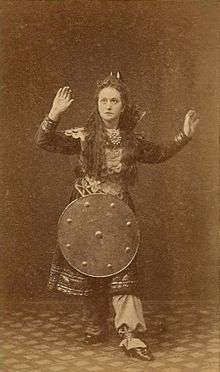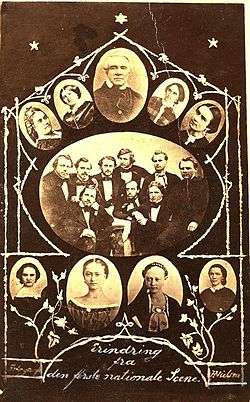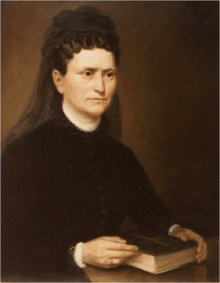Fredrikke Nielsen
| Fredrikke Nielsen | |
|---|---|
 Fredrikke Nielsen's portrait in the 1850s. The Theater archive, University of Bergen. | |
| Born |
Fredrikke Louise Jensen 5 July 1837 |
| Died | July 7, 1912 (aged 75) |
| Occupation | Actress and preacher |
| Years active | 1853–1880 (actress) |
| Spouse(s) | Harald Nielsen (actor) |
Fredrikke Nielsen (born Fredrikke Louise Jensen July 5, 1837 on Avaldsnes, Rogaland, death July 7, 1912 in Bergen) was a popular and well known Norwegian actress. She later went into the Methodist Church, in 1880 she became a preacher, and devoted the rest of her life to mission trips around the Nordic countries and the United States.
Early life
Fredrikke Nielsen grew up on the farm Brathammer on the South-West coast of Norway, with her aunt Bretta Endresdatter Grønhoug and her husband, Johannes Johannessen.[1] Eight years old she was taken to Bergen. It was not until adolescence that she discovered who was her real mother. Her mother was Anna Grønhoug, which she so far had believed was her aunt in Bergen. After this Fredrikke was living with her mother, who had married the alcoholic wheelwright, Jacob Einersen Rognved. Her biological father was a Danish chemist, Ulrik Rostrup, who had traveled to United States, and a bit later took up residence in the Panama. There was perhaps not any adequate consolation, but her father had not forgotten her. Rostrup bought shares in Fredrikke's name, and then she received some nice payouts from Panama. Rostrup also came to Bergen to meet his daughter after she was married.
Debut and working at the theater


After being statist, Fredrikke Jensen just 16 years old got her theater debut 14 December 1853 in the play What she can lie. Fredrikke was a permanent employee at the Det norske Theater in Bergen from 1853 to 1861, and was educated by Herman Laading and the playwright Henrik Ibsen. As her own life memoirs gives several examples she had an intimate relationship with Ibsen. The playwright praised her as a favorite actress and gave her key roles in his own piece The Feast at Solhaug (1856). Regarding the first performance, she even told how Ibsen came up to her, gave her blessing hands over her head and said, "Rest now the Lord’s angels over you" (Nielsen 1998:90). To her actress colleague, Octavia Sperati, Fredrikke also announced that the play was written with special focus on herself. When Octavia threaded the story four years after Fredrikke’s death, she misunderstood what the piece it was, and took it to be the sequel Olaf Liljekrans,[2] but her details of the incident is still interesting: "The evening when Ibsen's play "..." was first performed, she played the lead role in this piece, which Ibsen had written with a special focus on her. Filled with anxiety, she stood outside and waited for his entrance. In the background Ibsen walked with nervous steps forward and back, but suddenly he turns himself to her, extending his arms to her and exclaims: "God follow you, when you enter the stage." (Sperati 1916:15).
After the Actor's riot with Bull, who returned from many years of touring the world set out to 'clean up' in the theater, she remained at the stage in Bergen until 1861. Now received both her and her husband employment at the Norwegian Theatre in Trondheim. From 1865, she worked for her husband's Norwegian theater company. With interruptions for the years 1867 to 1868 when she was related to Th. Cortes' company, she belonged spouses theater company to 1870. In the years 1871-1872 she worked for Hans Sørensen's theater company.
Marriage
Fredrikke married actor colleague Harald Nielsen (actor) (1831-1882) on 27 November 1856. The playwright Henrik Ibsen wrote a song to their wedding:
Song at Actor H. Nielsen and Actress Miss F. Jensen's Wedding
27 November 1856
Mel: Aa Kjøre Vatten etc.
Upon the stage — it's by ancient lore —
The play can properly be ended
When the conquering hero's come home from war
And won his “She”, his intended!
One could believe life's poetry had ceased
Quite absolutely with the wedding feast.
The pair could well
Have ceased to dwell
From that day forth in Art's fair regions!
But look, in life that is never true,
The ideal there's continuation,
The bright, the beckoning heavenly blue
That claims all our concentration;
When church has blessed the vow two hearts have made
Then on their union there's a splendour laid;
Spring-like and rare,
Poesy-fair
Life lies ahead for the couple.
You twain, whom fire within your hearts
And churchly vow have just married,
Go, boldly tackle the real-life parts,
The variable scenes to be carried, —
But if at times the problems prove severe —
Keep up the spirit that inspires you here,
Then without trace
Of fear you'll face
The time for bringing down the curtain!
Henrik Ibsen
Harald Nielsen later worked as a stage manager, but eventually ended up being a well renowned photographer in both Trondheim and Bergen.[3] They got ten children. Four of these died early.
Den Nationale Scene and Henrik Ibsen
Both psychologist Arne Duve and professor in philosophy, Arild Haaland, took it almost for granted that there had existed a premarital love affair between Fredrikke and the young Henrik Ibsen (Duve 1977, Haaland 1978:173). When the first part of Fredrikke Nielsen's lost autobiography was recovered (in draft for a Swedish translation), it seems - despite its understated portrayals - just further to provide confirmations of intimate cooperation between the two. Also the Ibsen scholar, philologist and linguist, professor Harald Noreng, who published her memoirs, pointed out such a potential relationship, Noreng added a section to the book where he exhibits and discuss elements of Fredrikke's life and events in Ibsen's works, with particular impact on his later contemporary dramas (Noreng 1998:110-158).
After all, Fredrikke must probably have been in the writer's mind when he formed the main character Hjørdis in The Vikings at Helgeland. She was the first to create the role when the play was set up for the first time in Bergen on 4 March 1859. As Ibsen himself had then left Bergen, it was Bjørnstjerne Bjørnson who was the instructor. At the opening performance of Den Nationale Scene, 27 October 1876, she played the lead character again as Hjørdis in Henrik Ibsen’s The Vikings at Helgeland. Colleague Octavia Sperati recalled from Den Nationale Scene in 1876, that "Mrs. Fredrikke Nielsen fantasifulde, dæmoniske Hjørdis was of great effect ..." (Sperati 1911:89).[4] Also Professor Harald Noreng agreed that this piece gave Fredrikke ample opportunities to play out the "dark and aggressive sides of her own artistic temperament ... " (Noreng 1998:114).
Ibsen himself explained his inspiration for the central female characters in both this and in his next drama, Love's Comedy; ""The Vikings at Helgeland" I wrote when I was engaged. To "Hjørdis" I have used the same model, as I later did to "Svanhild" in "Love's Comedy." The urge for liberation, going through this epic poem [= On the Heights] did not receive its full expression before "Love's Comedy" - " (HIS 12 2005:427).
Den Nationale Scene, Ole Bull and Bjørnstjerne Bjørnson
In the years 1863 to 1876, Bergen had no own theater company, so the Danish "Rasmussenske Company" acted more or less as a "Town Theater." They had also laid claim on the old Comedy House in summer and autumn of 1876. In anticipation of the theater building to be free, the actors who were to form Den Nationale Scene exercised in the Labor Association’s small hall. One day Ole Bull himself turned up to attend their rehearsals:
"It cannot be denied - it jumped like a little bit in each of us to hear that we should have our world famous violinist sitting there at first row during our often tentative work. But it lasted only a moment. His heart-winning, forthright manner, and the obvious enthusiasm for the task that he brought in, gave us quickly our courage back.
We'd tried on "Between the battles." The female lead, Inga, was played by Mrs. Fredrikke Nielsen, in her time a well-known and highly gifted actress. After the exercise Ole Bull went forward and embraced her first, and then all of us. Then addressing himself to all with a short, impromptu speech. In his opinion the task we had set ourselves, would probably succeed. Soon we could present the Danes and Swedes, that we Norwegians too could play comedy." (Garmann 1900:94-95).
Fredrikke Nielsen took the task seriously as an actor. When Den Nationale Scene in the autumn of 1878, had plans to perform Bjørnstjerne Bjørnson’s Sigurd the Crusader, she wrote to the author (20 June 1878), that she wanted to go through Borghild role with him: "Thus I hope to render it better, especially the first part which now seems pretty difficult to me. My stay with you shall not last more than one day" (NBO brevs BB). Bjørnson was not exceedingly excited about taking up his historical drama from 1872, and wished that the ensemble also went on to play the contemporary dramas that he now dealt with:
”And Borghild! - Now, it is entirely for you; - I am far past all that historic. I am in the present with all my soul, which incidentally you too are to the extent that I would want you on all stages of a character in the play, which has just been completed, and also one connected with this which I work on" (NBO brevs BB). Ovtavia Sperati confirmed that Fredrikke really visited Bjørnson at Aulestad for guidance, but that it was not Sigurd the Crusader, but Leonarda, that was the subject for the visit. The play had already been performed in April 1878, with Fredrikke as lead actor. According to the newspaper reviews she was personally to blame for the fact that the play was no success: "This gave her no peace and may have been the reason for her holiday visit to Bjørnson at Aulestad. She was received with open arms by her old friend and helper, and she played the role of Leonarda for him and won the writer's overall recognition" (Sperati 1911:181).
Both through Fredrikke Nielsen's life, and what seems for her to have been a duty wise arranged marriage to be able to concentrate on her tasks to be an artistic professional actress, are all factors which may have given Ibsen inspiration to some crucial issues in Svanhild's role in his play Love's Comedy (1862) and several others (Edvardsen 2012:112). Also Fredrikke Nielsen must have recognized personal characteristics in Svanhild's figure. Octavia Sperati explains what a huge disappointment Fredrikke experienced when the play was finally set up in Bergen. Theatre instructor Niels Wickstrøm was aware of the burning desire Fredrikke had to perform "Svanhild’s delicious stanzas", but felt she was too old to be awarded her role of life.
”The performance of "Love's Comedy" was apparently to blame, that the theater lost a significant actress. One day right after the role-holders for the play was dealt, I met with Mrs. Nielsen. She was in passionate revolt. "Have you heard, I will be playing Mrs. Halm?" she exclaimed. "Straw! H - a - l - m, Halm – a straw – colorless, withered – dry – dead – death! Yes, it is in the word. This straw I have to perform, I which have been looking forward to recite Svanhild's delicious stanzas. From the piece came out, I've rehearsed the role "- ... Shortly after Ms. Nielsen sent in her resignation. (Sperati 1911:196f).
At the premiere 31 October 1879, she had to play the mother's role. The last performance she took part in was 17 June 1880, as Ms. Bernick in Ibsen’s The Pillars of Society. In many ways Fredrikke Nielsen's artistic life was framed within Henrik Ibsen’s practical work in the theater in Bergen and the plays he wrote. Ibsen was, along with Herman Laading, her instructor and mentor when she started her career as an actress. Ibsen chose her to designing key roles in several dramas, while they were working together at the Norwegian Theatre in Bergen.
In addition, a number of scientists (i.e. Arne Duve, Arild Haaland, Willy Heggøy, Harald Noreng) have pointed out her close biographical connections to Ibsen's female characters in dramas such as Olaf Liljekrans, The Vikings at Helgeland, Love's Comedy, Ghosts, The Wild Duck, The Lady from the Sea and When We Dead Awaken.
Preacher

In 1880 Fredrikke Nielsen underwent a religious revival and became a preacher for the Methodists. The religious community did not allow her ever more to set foot in a theater, but she still maintained some connection with Bjørnstjerne Bjørnson both through correspondence and with personal meetings.
Fredrikke Nielsen was still keen to read fiction. Having immersed herself in Arne Garborgs novels Peace and The Prodigal Father, she contacted the author for help to review their own life memories (NBO Brevs 140). During propagation she never refused nor to speak of social issues in America or parenting and temperance movement.
Notes
- ↑ The surname Jensen was because she in the ministralbook for Avaldsnes was mentioned as illegal child of "maid Anna Grønhoug" and "... as father alleged bachelor Fredrik Jonsen from Stockholm ", an obviously fictitious person.
- ↑ It is not strange that Octavia Sperati perceived it to be about native child Alfhild in Olaf Liljekrans, considering Fredrikke’s own background, but in this case it was Louise Brun who played the lead female role as Alfhild. Fredrikke did not play any role in Olaf Liljekrans, a piece that, despite great expectations and full house, became a spectacular failure. Ibsen himself understood its weaknesses, and despite good audience increase, Ibsen took it off after only two performances, and started rewriting it to the operalibretto The Mountain Bird, which he never finished.
- ↑ The playwright Henrik Ibsen wrote a song to their wedding (HIS 11 2009:218-219).
- ↑ Fredrikke must also have accepted Octavia Sperati’s interpretations. In a letter of 15 January 1912 she thanked Octavia for the descriptions of herself (NBO Brevs 648).
External links
Bibliography
| Wikimedia Commons has media related to Fredrikke Nielsen. |
- Blanc, Tharald: Norges første nationale Scene (Bergen 1850-1863). Et Bidrag til den norske dramatiske Kunsts Historie. Kristiania 1884. Albert Cammermeyer.
- Blytt, Peter: Minder fra den første norske Scene i Bergen i 1850-Aarene. (2. opl.). 1907.
- Duve, Arne: The Real Drama Of Henrik Ibsen? Oslo 1977. Lanser.
- Edvardsen, Erik Henning: «Kjærlighedens Komedie, Illustreret Nyhedsblad og Hollenderkretsen» (s. 103-134) In: Eivind Tjønneland (red): "Gloria Amoris. Henrik Ibsens Kjærlighedens Komedie 150 år". Bergen 2012. Alvheim & Eide Akademisk Forlag. ISBN 978-82-90359-87-9
- Folkebladet: «Den første nationale Scene i Bergen» (s. 19-28). Folkebladet No. 2. 31te Januar 1900.
- Garmann, Fredrik: En skuespillers Oplevelser. Erindringer fra mit theaterliv ved Holger Sinding. Kristiania 1900. Aschehoug.
- Haaland, Arild: Ibsens verden. Oslo 1978. Gyldendal Norsk Forlag. ISBN 82-05-10868-4
- Heggøy, Willy: Den skjønne Fredrikke. Om Fredrikke Nielsen. Nasjonalbiblioteket NBO Ms. 4° 4305.
- HIS = Henrik Ibsens skrifter. [i.e. Collected Works].
- Jensson, Inger: Biografisk skuespillerleksikon. Norske, danske og svenske skuespillere på norske scener særlig på 1800-tallet. Oslo, Bergen, Tromsø. Universitetsforlaget.
- Nielsen, Fredrikke: Minnen från min barndom och mina första ungdomsår. Ibsenhuset og Grimstad Bymuseum. Skrifter nr. 7. Oslo 1998. Novus Forlag. ISBN 82-7099-294-1 (h).
- Noreng, Harald: Tillegg. Henrik Ibsens diktning i Fredrikke Nielsens liv og Fredrikke Nielsens liv Henrik Ibsens diktning. I: Fredrikke Nielsen: op. cit.. Oslo 1998.
- Sperati, Octavia: Teatererindringer. Gyldendalske Boghandel, nordisk Forlag. Kristiania og Kjøbenhavn 1911.
- Sperati, Octavia: Fra det gamle Komediehus. Gyldendalske Boghandel, nordisk Forlag. Kristiania og Kjøbenhavn 1916.